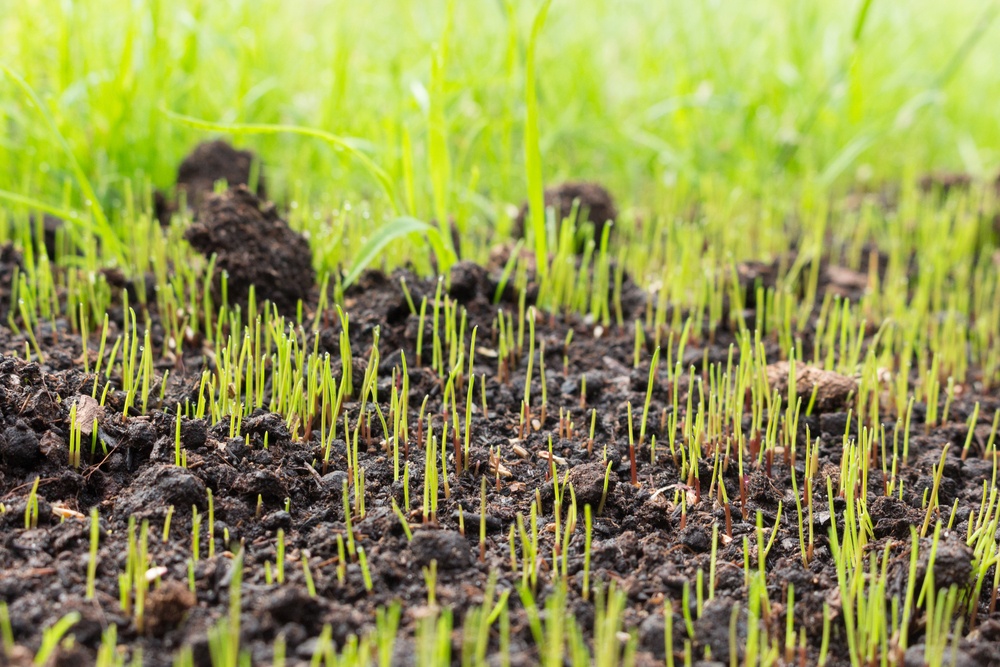When starting planting grass seeds, you might wonder when the garden is lush and greenery. Well, it won’t happen overnight. First, the grass seeds will grow with tiny shoots. After this, the seeds need to finish root establishment.
So, how long does it take for grass to grow? It can take as fast as 5 days and as long as 30 days. The estimated time depends on the grass type and temperature.
Cool-season grasses grow faster than warm-season ones. These include bentgrass, ryegrass, fescue, and bluegrass. The germination period of these grasses ranges from three days to 14 days.
On the other hand, warm-season grasses germinate from at least 5 days to 30 days. Take centipede grass, Bermuda grass, Buffalo grass, and Zoysia grass as examples.

For example, Rye grass can grow into a plant in five days, but it can also take 10 days with cooler weather. And Zoysia grass can germinate from 10 days to three weeks.
However, a lawn can have a mix of various grasses. A hard-wearing grass mixture germinates within a week. The typical combination is red fescue grass and ryegrass. With the high-quality variant, the germination is two weeks. Take bent grass and smooth meadow grass as an example.
You can look for your grass type in the table below and find out its germination time.
| Grass | Germination Time |
|---|---|
| Bahia | 7 – 21 days |
| Bentgrass | 10 – 14 days |
| Bermuda grass | 10 – 30 days |
| Buffalo grass | 14 – 30 days |
| Centipede grass | 14 – 21 days |
| Fescue | 7 – 14 days |
| Zoysia | 14 – 28 days |
| Kentucky bluegrass | 14 – 30 days |
| Orchardgrass | 12 – 24 days |
| Rough bluegrass | 7 – 10 days |
| Ryegrass | 5 – 10 days |
| Timothy | 7 – 14 days |
| Tall fescue | 4 – 14 days |
After searching in the table, to have fast germination, read about how grass grow in a specific area. This guideline below will consider planting period and watering.
For quick growth, you should plant grass in the right season. Cool-season grasses should ideally be grown late in the summer or early in the fall. Plants will have enough time to grow before the cooler temperatures in the winter.
For warm-season varieties, you should plant them late in the spring season. The roots will be firmly established in the soil before the hot summer days come around.
Regardless of the grass type, you must always keep the ground in top shape for seed planting. Take out any rocks and debris in the area. Remove currently planted vegetation to reduce the risk of plants competing for nutrients. Furthermore, loosen the soil with either a tiller or a rake.
You need to get a starter fertilizer before planting the grass too. In particular, we recommend getting a 12-2510 fertilizer spread. Every one thousand square feet of land requires from five to eight pounds of the fertilizer.
As with any plant, watering is a significant factor for growth. In fact, in the germination period, pay attention to the amount of water. Two days before planting the grass seeds, you need to water the area.
The lack of water would dry the seeds out while overwater will lead to rotting. Both of these scenarios are bad for the germination phase. Puddles are sign of watering too much.
The top two inches of the soil needs to stay moist all the time. To determine the level of moisture, put your finger in the soil and stop when it reaches a dry section.
On average, you need to water the area once per day. However, strong winds and hot temperature can persuade you to water the lawn more than once.
Besides, it would be best to step away from the grass seedlings sections. Simply walking over this area could compact the soil or deepen the seed placement. If any of these two things happen, germination could be delayed.
As you’ve read from our guide, the germination of grass can be as short as three days or as long as a full month. It’s not just the grass type and temperature that affect the growth period. Irrigation, fertilizers, planting season, and soil preparation delay or speed up grass growth.
In addition, don’t forget to mow your lawn frequently if your grass have grown to a certain height. Cutting off 2 or 3 inches of grass can help get rid of weeds and make your new lawn look more beautiful. You should also remember to water your grass before mowing to protect your mower’s blades.
Related post: Top 7 Best Corded Electric Lawn Mower ReviewsThus, you need both patience and knowledge if you want your grass to grow as quickly as possible. We hope this guide helped you in developing your property.
If you have any questions, drop us a comment.